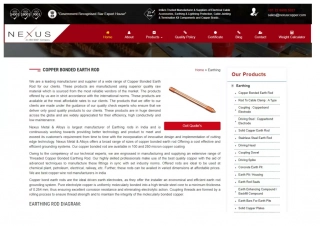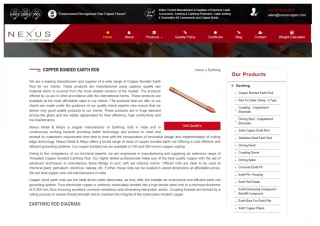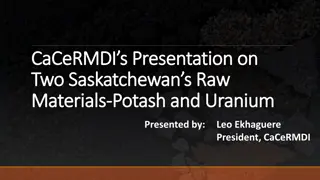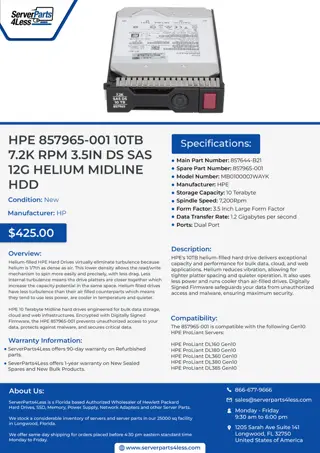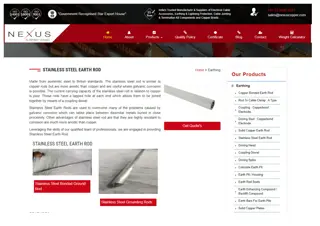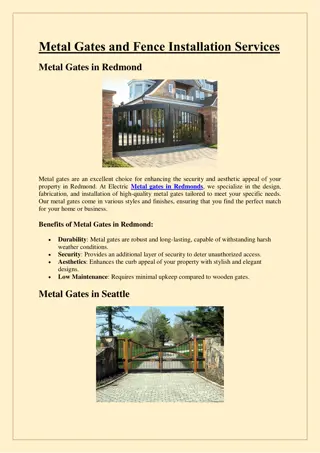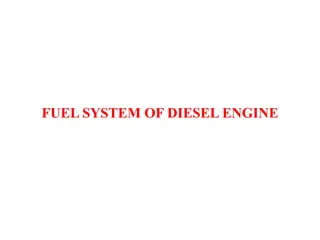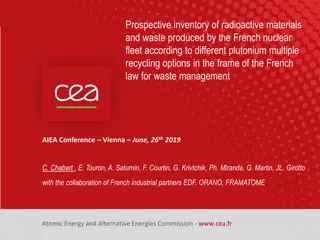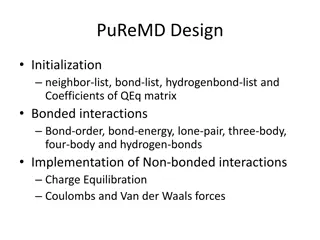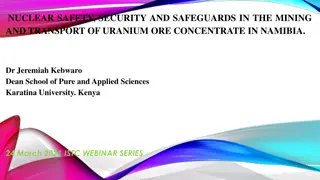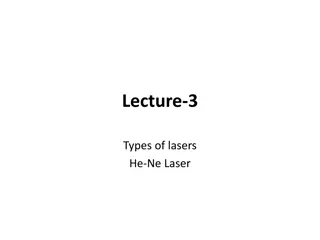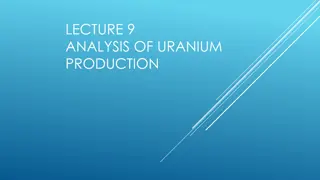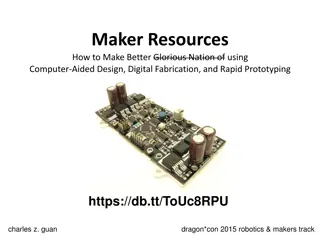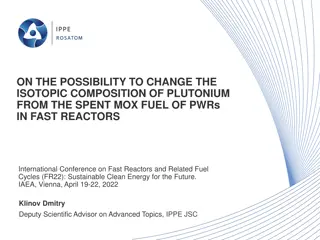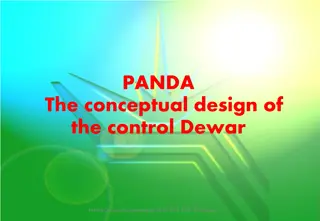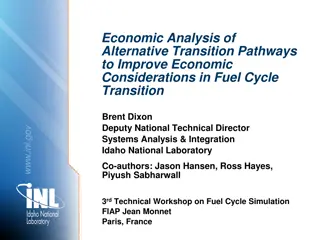Investigation of Swelling in Uranium-Plutonium Nitride Fuel for Helium Gas Fabrication and Liquid Metal-Bonded Test Fuel Rods
This study examines the specific details of swelling in uranium-plutonium nitride fuel used for fabrication of helium gas and liquid metal-bonded test fuel rods. Key irradiation parameters, examination techniques, and the structural and phase state of SNUP fuel after low-temperature irradiation are discussed, along with fission products distribution in SNUP fuel. Various analyses such as gamma-scanning, EPMA, XRD, and quantitative metallography were employed to investigate fuel swelling and changes in fuel properties with irradiation.
Download Presentation

Please find below an Image/Link to download the presentation.
The content on the website is provided AS IS for your information and personal use only. It may not be sold, licensed, or shared on other websites without obtaining consent from the author.If you encounter any issues during the download, it is possible that the publisher has removed the file from their server.
You are allowed to download the files provided on this website for personal or commercial use, subject to the condition that they are used lawfully. All files are the property of their respective owners.
The content on the website is provided AS IS for your information and personal use only. It may not be sold, licensed, or shared on other websites without obtaining consent from the author.
E N D
Presentation Transcript
Specific details of swelling in uranium Specific details of swelling in uranium- -plutonium nitride fuel used for fabrication of helium gas nitride fuel used for fabrication of helium gas- - and liquid metal and liquid metal- -bonded test fuel rods bonded test fuel rods plutonium A.V. Belyaeva, F.N. Kryukov, O.N. Nikitin, and S.V. Kuzmin (JSC SSC RIAR ) XI CONFERENCE ON REACTOR MATERIALS SCIENCE May 27-31, 2019 Dimitrovgrad
Key irradiation parameters of fuel rods with uranium-plutonium nitride Fuel meat composition U0,4Pu0,6N helium steel ChS-68 12,16 0,05 15,1 0,4 U0,82Pu0,18N lead steel EP-823 13,08 0,07 8,5 0,5 Heat-transfer substrate Cladding material Fuel density, g/cm3 Porosity, % Mass fraction of impurities: oxygen < 0,01 < 0,15 carbon Fuel pellet diameter, mm Nominal fuel rod diameter, mm Nominal cladding thickness, mm Fuel meat length, mm 5,88 0,03 6,9 0,4 450 3 7,85 0,05 9,4 0,5 390 4 2,81) 4,02) 5,53) 7,01) 12,12) Max calculated burnup, % h.a. Max calculated linear thermal power of a fuel rod (irradiation start/end), W/cm 545/350 435/424 Max calculated fuel T (irradiation start/end), 1760/1150 875/784 2
Examination techniques Fuel elementary and phase composition: gamma-scanning EPMA XRD Fuel macro- and micro-structure: Optic metallography of cross-sections SEM cross-sections and fractures quantitative metallography 3 3 3 2 2 2 4 1 1 1 a b c Fuel swelling: - Fuel meat geometric measurement change ?? ?0 ?0 =? ?0 f d e - Fuel density change Figure 1 sample in the drum for metallography (a), EPMA(b), XRD (c) and typical images (d, e, f): 1 - sample, 2 Wood alloy, 3 metallographic drum, 4 grinding line ?? ?0 =?0 ? ? where V0, V fuel meat volume; 0 fuel meat density before and after irradiation, respectively 3
Structural and phase state of SNUP fuel after low- temperature irradiation up to 4%h.a. 1 1 2 3 2 3 30 30 30 b Figure 2 Macro ( )- and microstructure (b) of fuel along the fuel pellet radius on the cross-section: 1 near the cladding, 2 radius center, 3 fuel pellet center a 0.4904 0.4902 Crystalline structure parameter, nm 0.4900 - 550-850 - 400-500 0.4898 0.4896 0.4894 0.4892 0.4890 0 2 4 6 50 Bunrup, % h.a. Figure 4 Changes of crystalline lattice parameter with the burnup Figure 3 Typical microstructure 4
Fission products distribution in SNUP fuel after low- temperature irradiation up to 4 % h.a. e Cs Nd Zr Cs - 50 Figure 5 microstructure in back-scattered electrons ( -) fission products distribution maps (Nd, Cs, Zr) Pd 1800,0 Table 1 Main fission products in fuel U0,82Pu0,18N (wt. %) 1600,0 1400,0 Ru-103 103Ru Average value over the radius Radius center Calculated amount 1200,0 , / Element Fuel center Fuel edge 1000,0 106Ru 800,0 Ru-106 Mo 0,36 0,06 0,34 0,06 0,32 0,06 0,34 0,06 0,3372 600,0 Mo Mo Cs-137 137Cs Pd 0,18 0,03 0,19 0,03 0,19 0,03 0,19 0,03 0,2276 400,0 200,0 Cs 0,47 0,04 0,46 0,04 0,46 0,04 0,46 0,04 0,4383 0,0 300 400 500 600 700 800 900 1000 Nd 0,37 0,03 0,37 0,03 0,36 0,03 0,37 0,03 0,3646 , Figure 6 Distribution of fission products emission intensity longwise the fuel rods 5
Peculiar microstructure of SNUP fuel after low- temperature irradiation up to 5,5 % h.a. a 30 m b 10 m Figure 7 Fuel microstructure on the cross-section (a) and fracture (b) of the pellet Large voids are surrounded with a restructured matrix Areas with increased concentration of small (submicron) voids + Changes in microstructure 6
Peculiar microstructure of SNUP fuel after low- temperature irradiation up to 5,5 % h.a. c a b 10 m 50 m 5 m d f e Figure 8 Fuel microstructure with no restructuring (a) and restructured area (b,c), voids distribution (d, e) and sub-grains (f) 7
Distribution of fission products in SNUP fuel after low- temperature irradiation up to 5,5 % h.a. e Nd Zr Ru Mo Cs 50 Figure 9 back-scattered electron image ( -) and main fission products distribution maps (Zr, Tc, Ru, Nd, Mo) 0,8 0,7 Xe, % 0,6 0,5 0,4 0,3 0,2 0,1 0 0 50 100 150 200 250 300 350 , 0,8 Figure 10 fuel micro-structure at the pellet edge (a), xenon distribution map (b) xenon distribution along the scanning line (c) Fission products release into sub-micron voids under low-temperature irradiation 0,7 Xe, % 0,6 0,5 0,4 8 0,3 0,2 0,1 0 0 50 100 150 200 250 300 350 , 0,8 0,7 Xe, % 0,6 0,5 0,4 0,3 0,2 0,1 0 0 50 100 150 200 250 300 350 ,
Change of fuel pellet diameter after low- temperature irradiation 1 a b Figure11 Measurement of fuel meat diameter (a) and pellet fragment areas (b) Figure12 Pellet diameter vs. local burnup in the fuel rod cross-section At a stable diameter increase rate, the fuel-to-cladding contact will occur at about 9% h.a. under normal operating conditions 9
Contribution of different factors in to SNUP fuel swelling after low-temperature irradiation 9 9 8 8 7 7 Swelling, % Swelling, % 6 6 5 5 4 4 3 2 3 1 2 0 1 2.8 4 0 5.5 0 1 2 3 4 5 6 Burnup, % Local burnup, % h.a. Figure14 Swelling of U-Pu nitride fuel under low-temperature irradiation and contribution to swelling due to: Figure13 Swelling of U-Pu nitride fuel vs. local burnup in the fuel rod cross-section change in volume unit cell ( ), Increase in unit cell quantity and secondary phases ( ), FGR into voids( ) 10
Typical microstructure of SNUP fuel after high- temperature irradiation Pellet edge Radius center Pellet center Process voids gas voids Inter-grain voids 20 20 m 20 m (state close to initial) Figure15 Microstructure of U-Pu nitride fuel on the cross-section FG accumulation and release from the matrix Separate gas and process voids unite into chains along grain boundaries Gas voids inside and at the grain boundaries Secondary phases Solid fission products accumulation and release from matrix Secondary phases 11
Distribution of voids and FG over the pellet radius after high-temperature irradiation 1.6 40 Xe mass fraction % 35 1.4 30 1.2 Porosity, % 25 1.0 20 0.8 15 0.6 10 0.4 5 0.2 0 0 500 1000 1500 2000 2500 3000 0.0 0 500 1000 Distance from the center, m 1500 2000 2500 3000 Distance from the pellet center, m Figure18 Xenon distribution along the pellet radius Figure16 Porosity distribution along the pellet radius 10 Pellet center Radius center Pellet edge Figure 17 SNUP fuel microstructure at the fracture 12
Typical FP distribution in SNUP fuel after high-temperature irradiation e Cs e e 137Cs 50 Pd Mo Figure19 137Cs intensity distribution longwise fuel rod Zr 0.4930 Crystalline lattice parameter, 0.4925 0.4920 0.4915 Nd Zr nm 0.4910 0.4905 0.4900 0.4895 0 2 4 Burnup, % h.a. 6 8 10 12 14 Figure 18 Image in back-scattered electrons ( -) and FP distribution map (Cs, Pd, Mo, Nd, Zr) Figure 20 Change in SNUP fuel crystalline lattice parameters vs. burnup 13
SNUP fuel swelling after high-temperature irradiation 16 Swelling, % Due to increase in the elementary crystalline cell parameter - 1,1 0,1% 15 14 13 12 11 Due to unit cell increase and FP- containing secondary phases - 1,4 0,2 % 10 9 8 7 6 0 50 100 150 200 250 300 350 400 450 Distance from the fuel meat bottom, mm Due to generation and growth of all types of gas voids (inside and at the grain boundaries) because of FG accumulation and release - 11,8 1,0 % Figure 21 Swelling change heightwise fuel meat 14
Free and restrained nitride fuel swelling under high-temperature irradiation 3,7 % h.a. 5 % h.a. 5,4 % h.a. 1 No gap Gap size 5-10 m 50 m 50 m 50 m Figure 21 Fuel macrostructure (top) and microstructure of fuel-to-cladding contact (bottom) Average fuel swelling rate Before contact to cladding 1,8 0,2 %/% h.a. After contact to cladding 1,2 0,1 %/% h.a. 15
Conclusions Signs of restructuring of fuel composition (U0,82,Pu0,18) N, irradiated as part of liquid metal-bonded fuel rods in the temperature range 500-880 C were found when the threshold burnup reached about 5.5%h.a., i.e. a sub-grain structure accompanied by an athermal FGR from the solid solution into voids. The phenomenon of restructuring detected under low-temperature irradiation of nitride fuel leads to a change in the mechanism of its swelling: the value of swelling due to an increase in the volume of solid solution associated with the formation and accumulation of solid FP (with an initial burnup level of up to 4%h.a.) is added by swelling due to the formation and growth of gas-filled voids that appeared during restructuring (at a burnup of 5.5%h.a.). The maximum swelling value was 8% with a local burnup of 5.5%h.a., of which 2.1% is due to the formation of gas-filled voids and 5.9% is due to the change in volume due to solid fission products located in the crystalline lattice of uranium-plutonium nitride and in the form of secondary phases. If the specified swelling rate is maintained, the fuel-to-cladding contact in the fuel rods of this design will occur at about 9%h.a. 16
Conclusions When analyzing swelling of U0,4Pu0,6N fuel composition irradiated in a fuel rod with a helium sub-layer in the temperature range from 1000 to 1760 C, two stages were distinguished: a stage of free swelling before the fuel-to-cladding contact and a stage of swelling under mechanical retention from the cladding. It was shown that for this design of fuel rods and irradiation conditions, the fuel-to-cladding contact occurs at a local (in cross-section) burnup about 5%h.a. The free swelling rate before the fuel-to-cladding contact was 1.8% /% burnup. After contact, the swelling rate decreased to 1.2% / burnup, which is associated with a decrease in the operating temperature of the fuel and the effect of compressive stresses from the cladding. Swelling of uranium-plutonium nitride fuel irradiated in fuel rods with a helium sub- layer occurred due to the accumulation of solid fission products that are in a state of solid solution in the SNUP fuel crystalline lattice or as independent phases, as well as due to the formation and growth of all gas voids due to the FG accumulation and release. The maximum swelling over the entire period of irradiation to burnup 12.1% h.a. 17
! Thank you for attention! 18


